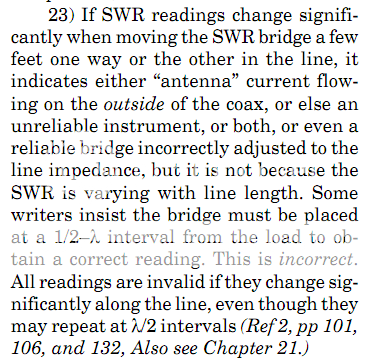Below are many pictures showing what 100' of RG58A/U coax does to your apparent SWR reading.
This shows the effects of coax on SWR to those who don't understand the math behind it, or are simply to lazy to do it themselves.
The SWR graphs have two lines, the top line is from plugging the terminator directly into the analyzer, the bottom line is from adding 100 feet of RG58A/U coax in between the terminator and the analyzer and rescanning.
If you don't know what a terminator is, think of it as a dummy load with a different impedance.
The middle line is the center frequency of the CB band here in the US.
The first graph was to demonstrate the effects of a 1.5:1 SWR antenna. The bottom line shows 1.2:1 SWR. So if you use 100 feet of RG-58A/U and see 1.2:1 SWR what you are actually getting is 1.5:1 SWR.

The second graph demonstrates 2:1 SWR.

The third graph demonstrates 3:1 SWR.

The fourth graph was meant to demonstrate a 5:1 SWR, however they did not have a resistor of the correct size so I chose the closest one available. This one thus shows What 4.75:1 SWR would look like.

Obviously if you have different lengths of this type of coax the results will vary. Less length and the effects will be lessened, more length and the effects will be greater. Different types of coax, such as RG-8X will have different results as well.
The DB
This shows the effects of coax on SWR to those who don't understand the math behind it, or are simply to lazy to do it themselves.
The SWR graphs have two lines, the top line is from plugging the terminator directly into the analyzer, the bottom line is from adding 100 feet of RG58A/U coax in between the terminator and the analyzer and rescanning.
If you don't know what a terminator is, think of it as a dummy load with a different impedance.
The middle line is the center frequency of the CB band here in the US.
The first graph was to demonstrate the effects of a 1.5:1 SWR antenna. The bottom line shows 1.2:1 SWR. So if you use 100 feet of RG-58A/U and see 1.2:1 SWR what you are actually getting is 1.5:1 SWR.

The second graph demonstrates 2:1 SWR.

The third graph demonstrates 3:1 SWR.

The fourth graph was meant to demonstrate a 5:1 SWR, however they did not have a resistor of the correct size so I chose the closest one available. This one thus shows What 4.75:1 SWR would look like.

Obviously if you have different lengths of this type of coax the results will vary. Less length and the effects will be lessened, more length and the effects will be greater. Different types of coax, such as RG-8X will have different results as well.
The DB

